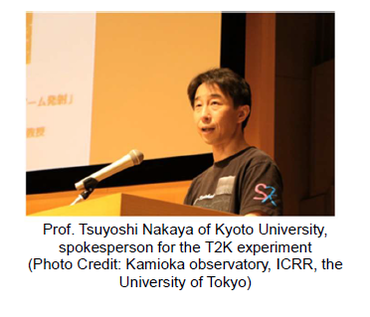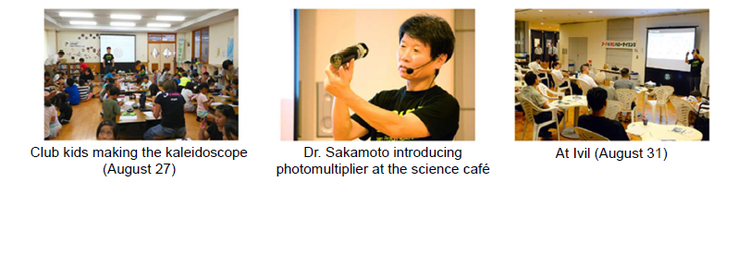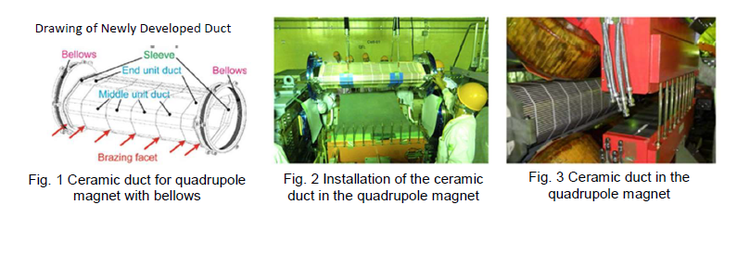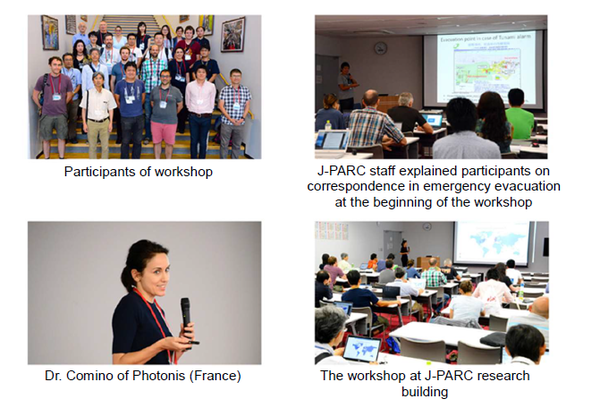J-PARC NEWS September 2018 (Issue #161)
■The 26th J-PARC Nuclear and Particle Physics PAC meeting was held (July 18 - 20, J-PARC)
For three days from July 18, J-PARC PAC, the Program Advisory Committee for Nuclear and Particle Physics Experiments at the J-PARC, was held. This time, it was held as a joint meeting of old and new committees, that is to say, the members who finished their term at the end of March this year, those who were continuing and those newly joined in April, where Mr. Rik Yoshida of Jefferson Lab in the U.S.A. took over the duties of chairman of the PAC from Mr. Junji Haba of KEK. At the committee meeting, progress and plans of the experiments currently being performed at the Hadron Experimental Facility and the Neutrino Experimental Facility of the J-PARC were reported by the person in charge, and adoption of the proposed issues was examined. Moreover, the current status and future plans for the J-PARC accelerator and an operation plan for the accelerator in 2018 - 2019 were reported and discussed.
 ■T2K collaboration meeting was held (August 20 - 25, Toyama International Conference Center, Toyama-city, Toyama)
■T2K collaboration meeting was held (August 20 - 25, Toyama International Conference Center, Toyama-city, Toyama)
On August 20 - 25, the T2K collaboration meeting was held at Toyama International Conference Center, where about 200 collaborators throughout the world met. This time, the analysis results of the data collected by the end of May this year, the future plans and so on were reported and discussed. Compared with the analysis results of the data by the end of last year*, the data on antineutrino beams had increased by approximately 50 percent, therewith properties between particles and antiparticles (CP violation) was being analyzed with higher precision and the achievement will be reported at an international conference this autumn. After the meeting, a tour of the Super-Kamiokande, which was undergoing maintenance and inspection work, was implemented. Moreover, on the 26th, a public lecture, "Ask neutrino about space", was held in which Professor Tsuyoshi Nakaya (Kyoto University), spokesperson of the T2K experiment, gave a lecture titled "Neutrino beam fired at Kamioka" on the current status of the T2K experiment.
* Reported at NEUTRINO2018 held in Germany in June 2018.
■ J-PARC Center Outreach Activities (August 27: Nakamaru After-school Child Day Care, August 31: Tokai Industry and Information Plaza "iVil", September 1: Tokai Village Library)
Hello Science was held twice in August, namely, in the evening of the last Friday and, responding to requests, in the afternoon of the following Saturday. Shinichi Sakamoto, a science communicator of the Public Relations Section, gave a lecture titled "Very First Introduction to the Particle Experiment" on the study of elementary particles in search of the origin of substances. He presented the principle of accelerators to generate particles, the measuring method of generated particles and the detectors, and then answered questions from the participants. Moreover, on August 27, a science experiment school was held at Nakamaru After-school Child Day Care, where children made a kaleidoscope of light and experienced how it looked different with a fluorescent lamp, an LED bulb and an incandescent lamp.
■KEK was open to the public (September 2, KEK Tsukuba campus)
On September 2, when morning rain stopped falling and the temperature became comfortable, the High Energy Accelerator Research Organization (KEK) opened its research facilities to the public and received approximately 3,500 visitors. The KEK is one of the joint operating organizations of the J-PARC. On the visiting route, J-PARC areas were provided in various places where the staff explained the outline of the J-PARC, the Hadron Experimental Facility, T2K neutrino oscillation experiments, muons and neutrons using panels and models. Moreover, a lecture on neutrinos was organized at the science café, where many questions were directed at the researchers.
*1 The model of a helium vessel and a crane in the neutrino target station (TS).
*2 The model representing the aspect of nuclear spallation by marbles. Many marbles (an atomic nucleus) are placed in the center cylinder (neutron source: blue) and, when it is hit by a marble (a proton) which came rolling from a tube, marbles (neutrons) scatter around and reach the surrounding cylinders (experimental devices).

■J-PARC general emergency training was carried out (September 6, J-PARC)
On September 6, general emergency training was carried out assuming a fire in the linac tunnel. In the training, cooperation with the on-site command office (J-PARC Research Building), the assumed incident occurrence post (LINAC Building) and the NSRI (Nuclear Science Research Institute) accident measures headquarter (Safety Management Building), communication and confirmation, simulated an examination to terminate the fire and so on were executed. In addition, a simulated press conference was held and many tough questions were asked by the staff in the role of journalists. A number of points will be sorted out to accomplish faster and more adequate responses.
■Ceramics ducts for quadrupole magnets were replaced by bellows ducts (3 GeV synchrotron (RCS))
Ceramics are used for beam ducts of a 3 GeV synchrotron (RCS) to prevent the beam from being subject to high-frequency electromagnetic induction. Since quadrupole magnets of the RCS injection section are installed in the upstream portion where the beam from the Linac and the RCS circulating beam join, ducts of large diameter and complex shape are used. This time, by replacing them with the newly developed bellows ducts, reduction of the stress pertaining to the connection with ducts at both sides and efficiency of maintenance and inspection were achieved. The replacement was completed during the summer maintenance period.
■International workshop on non-invasive beam profile monitors for hadron machines and related techniques, "3rd IPM* workshop" (September 18 - 20, J-PARC)
Workshops on non-invasive beam profile monitors for hadron accelerators and related techniques have been held over the last two years at CERN (Switzerland), GSI (Germany) and this year in Japan as a J-PARC workshop. A total of 35 people from research institutes and universities in and out of the country (including 16 people from seven foreign countries) participated in the conference, where 14 presentations were made on various equipment centering on the IPM tools used for accelerators, detectors and new ideas on which active discussion took place. At the special lecture on the 19th, under the title of "MCPs and MCP-based detectors", Dr. Raquel Ortega Comino of Photonis (France) talked about micro-channel plates (MCP) used in various devices as an electron multiplier. Moreover, on the final day, a J-PARC tour was undertaken.
* Ionization Profile Monitor
■The third J-PARC symposium will be held (September 23 - 26, 2019 at Tsukuba International Congress Center)
On September 23 - 26, 2019, the third J-PARC symposium will be held in Tsukuba. This year marks the 10th anniversary of the J-PARC facilities since the commencement of operation in 2008, therefore, taking advantage of the occasion, we will debate the future vision of the facilities with regard to advanced science and its industrial use at the J-PARC with the researchers of proton accelerator facilities throughout the world. We look forward to your participation. For more details, please refer to the following. http://j-parc.jp/symposium/j-parc2019/







